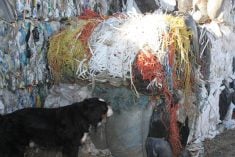An outline of the next farm income disaster assistance program is becoming clearer.
It will look much like a fine-tuned Agricultural Income Disaster Assistance program, offering money to farmers who can prove they have suffered a sharp decline in income during the past five years.
It will cover negative margins and try to deal with the special situation of farmers whose operation’s year-to-year income comparisons are skewed by periods of rapid expansion or contraction.
Senior bureaucrats still have to work out the details, which were to be discussed by federal and provincial agriculture ministers in a telephone conference call scheduled for earlier this week.
Read Also

Message to provincial agriculture ministers: focus on international trade
International trade stakeholders said securing markets in the face of increasing protectionism should be the key priority for Canada’s agriculture ministers.
Details will be announced within a month or two, once ministers approve final details of the program for 2000 and 2001.
“What they (farmers) can assume is that since ministers have said they want it based around the AIDA program, that will be the basic design,” federal agriculture minister Lyle Vanclief said in an interview Feb. 10.
However, some key questions remain to be answered.
Will Saskatchewan and Manitoba sign on to match Ottawa’s two-year, billion dollar commitment with their provincial share of 40 percent?
Vanclief said he remains adamant that both provinces must chip in 40 percent if their farmers are to benefit from the federal 60 percent share.
“My cabinet instructions on successor money gives me no authority to allow any province to go 60-0,” he said. “The critical thing is that they put up their 40 percent.”
How it is spent can be negotiated, but Ottawa will try to insist that national standards be met and that the spending be targeted to those most in need.
Vanclief said he is not certain yet where Saskatchewan will choose to fit into the next program.
“If they’ve given any indication, it is that they don’t want to be part of one. We put our money on the table. I strongly believe the money should be targeted.”
Ensure equal share
Another unresolved issue is where the money will come from to make sure that Saskatchewan and Manitoba don’t receive less from the basic federal $600 million safety net program.
It could cost more than $120 million over the next two years and officials have been trying to find a source for this money. Vanclief said he has tried to put to rest any provincial hope that Ottawa will throw more dollars into safety nets to cover the cost of the promise.
“Let’s be frank,” he said. “They’ve (the provinces) always hoped I’d go back to cabinet and ask for more money,” he said.
“I have made it clear to them that is not a possibility. There’s a long lineup at cabinet.”
The only alternatives are to take money out of the basic safety net funding or to reduce the amount of money available to the farm income disaster programs.














